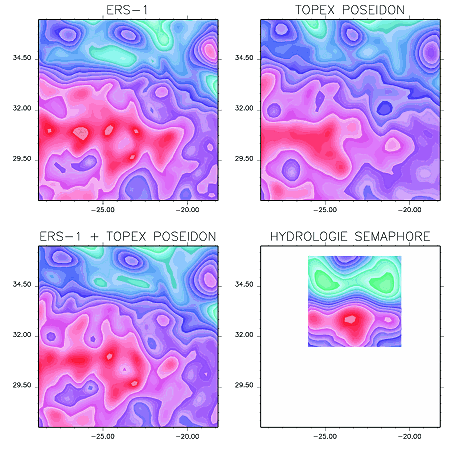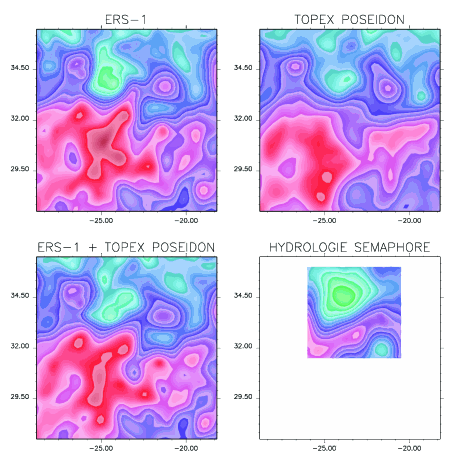Operational assimilation of TOPEX/POSEIDON and ERS-1 data into the French Navy's SOAP-93 forecasting system
E. Dombrowsky (CLS, France); B. Le Squère (CMO/BRESM, France)
The SOAP system
SOAP-93 is a preliminary version of an operational system for analyzing and predicting the ocean (French acronym: SOAP). Based largely on the assimilation of satellite altimetry data into a regional numerical model of the ocean, SOAP-93 is expected to validate the principle of operational use of an ocean model, especially for submarine acoustics applications. It is thus the first stage in implementation of a system for ocean analysis and prediction to meet the operational needs of the French Navy.
SOAP-93 is being developed in Toulouse under the prime contractorship of the Bureau de REcherches et d'Études SHOM-Météo (BRESM), a branch of the Centre Militaire d'Océanographie (CMO). The project started in 1991. After the specification, design and development phases, it began operationally in northern summer 1993, with ERS-1 Fast Delivery Products for the European Space Agency. It continued with TOPEX/POSEIDON (T/P) Interim Geophysical Data (IGDRs).
Near real-time data from ERS-1 and T/P is acquired, checked and processed once a week on SOAP-93 computers at the Navy's Cellule d'Environnement de la Marine (CELENV) at Météo France. These altimetry residuals are mapped and assimilated into an open-ocean quasigeostrophic model in a 1000 km x 1000 km area east of the mid-Atlantic ridge, south of the Azores and west of Madeira. Forecasts are then generated using the assimilation results to initialize. The forecasts are interpreted by an oceanographic expert for the hydrographic and dynamic situation and by an acoustics expert for the impact of the expected variability on acoustic propagation. The end products are distributed as graphics and text bulletins to Navy users.
Validating SOAP during the Semaphore experiment
The multi-disciplinary Semaphore experiment took place in northern summer and fall 1993, in a 500 km x 500 km section of the SOAP forecasting area. The SOAP forecasts were distributed to the ships doing measurements and the data collected in return used to validate the forecasts. Below are the results of the 15-day forecasts obtained in phases 1 and 3 in July and October 1993. We did three experiments, assimilating:
1. ERS-1 Fast Data Products
2. T/P IGDRs
3. ERS-1 FDPs and T/P IGDRs.
Figure 1 shows the SOAP dynamic height at 125 m relative to the 2000 m obtained according to three scenarios, and the equivalent observed from CTD data in the Semaphore experiment on July 13, 1994. In all four cases the Azores front is located 34°N, heading east. The dynamic height gradient (geostrophic velocities) in the three SOAP scenarios is weaker than that observed, especially for T/P. TOPEX/POSEIDON yields the same field as ERS-1 qualitatively, but with weaker amplitude. T/P sampling is not optimized for observing the mesoscale circulation. ERS-1 is gridded much more tightly in space and more loosely in time. The figure also shows an anticyclone at 23°30' - 35°30' in all four scenarios. This is confirmed by analyzing the tracks of drifters drogued at 150 m and launched during Semaphore. Simultaneous assimilation using the two satellites provides an intermediate situation between separate assimilations from each.

Figure 2 shows the results obtained on October 26 during phase 3. Note the strong meander in the Azores front, going north around an anticyclone at 25°30'W - 34°30'N and south around a major cyclone. A third anticyclone is present in the three SOAP scenarios at 21°30'W - 34°N. Its relationship with the front is different in each scenario.
A cyclone is forecast in the ERS-1 scenario and in the ERS-1 and T/P scenarios, south of the second one, at 21°30'W - 32°30'N, and was indeed partially observed during Semaphore. The cyclone is absent from the T/P-only forecast. The gradients mapped by assimilating ERS-1 and ERS-1 + T/P are consistent with those observed with the CTDs. They are, however, underestimated by T/P-only.

Conclusion
SOAP was implemented during Semaphore by assimilating data from ERS-1, or from T/P, or both. The results obtained are qualitatively consistent with in situ observations in terms of identification and location of features. The amplitude of the phenomena is generally under-estimated but is better handled by assimilating ERS-1 data than T/P. Using both altimeters is closer to the ERS-1-only solution than to T/P-only.
Work is in hand to improve methods for merging the data sets and accurately evaluate the gain. The T/P contribution as a complement to ERS-1 is twofold: T/P can constrain the larger scales non-observable by ERS-1 and can permit finer sampling of mesoscale features. Since the end of the ERS-1 multidisciplinary phase, the data has no longer been useable for mesoscale studies. We continue to assimilate T/P data and have supplied forecasts for phase 4 of Semaphore, conducted in northern summer 1994.




